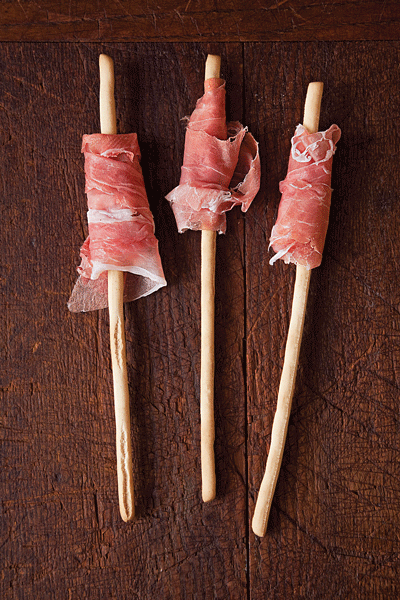
Numerous ingredients are naturally good pairings for ham's bold, salty flavors. Eggs, with their mild character and silky texture, are served with ham in many parts of the world, whether in a Western omelette, a cheese souffle (see Ham and Cheese Souffle), or a plate of pan-fried ham steaks with sunny-side-up eggs and a shot of red-eye gravy, made by deglazing the pan with a bit of brewed coffee.
Bread is an age-old companion to ham—a stack of buttermilk biscuits, say, a couple of slices of seeded rye, or a handful of crisp grissini (bread sticks)—because the starch softens the meat's rich taste.
Whether quickly brine-cured or long-aged, ham benefits from something sweet to counteract its saltiness; honey is often used in a glaze, or even in the brining mixture itself, as are Karo syrup, maple syrup, molasses, and sorghum. Everywhere from eastern Europe to the Caribbean, hams may be dry-cured and covered with a caramelized sugar crust.
Fruit, too, can provide the requisite sweetness; melon pieces or dried figs taste wonderful wrapped in silky prosciutto, and cooked ham is commonly matched with apples—as in the classic Pennsylvania Dutch dish schnitz und knepp, or ham and dumplings with dried apples—as well as with pineapple, a pairing that gained wide popularity in midcentury America (see the for a recipe for ** pineapple-chipotle-glazed ham**). Additionally, pineapples contain bromelain, an enzyme that works as a natural tenderizer for the ham. All over the world, from England to Brazil, cooks use whole cloves to lend tingly, spicy notes to ham's full flavors.
Another common complement is nuts; the Southern ham canon includes various stuffed hams filled with bread crumbs, dried fruit, and pecans—and also cubed ham and peanut salads.
Cooks in the United States have discovered that simmering ham in Dr. Pepper and Coca-Cola helps tenderize the meat; the soft drinks can also be reduced to make a sweet, flavorful glaze.
Mild-tasting seafoods, such as scallops and shrimp, are enlivened by salty cured hams like speck and smoked country ham.
Mustard's spiciness stands up to ham's flavor; mustard powder may be worked into a glaze, and jarred mustard of all kinds may simply be served as a condiment. Mostarda, the Italian fruit jam spiced with mustard seed, is often served with bollito misto, a boiled dish that contains many cuts of meat, including ham. Other spicy, tangy jams—like hot pepper jelly and chutney—are terrific when spread on a ham sandwich or a ham biscuit.
When it comes to herbs, ham's traditional partner is parsley, whose herbaceous notes offer a pleasing counterpoint to the rich meat, as in France's famed terrine de jambon persille, a ham and parsley terrine in aspic (see Ham and Parsley Terrine).
One of the most winning pairings for the meat is cheese, whether it's shards of Parmesan with prosciutto or Gruyere melted in a luscious croque monsieur, the quintessential ham and cheese sandwich.
Keep Reading
Continue to Next Story










